
Each piece in chess has its own unique powers. To become great at chess you must understand these powers and how they can be used to win the game. For each individual chess piece we will look at the starting position, movements, notation, general overview, and some additional pro tips to speed up the learning curve.
There are 6 unique chess pieces. They are:
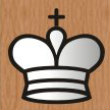



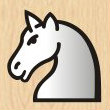

This page will cover where the chess pieces should start the game, how they move, how their moves are notated, and how good they are relative to the other chess pieces.
 The king is the piece with a cross at the top. This may not be the most powerful piece in chess, but it certainly is the most important. If you lose your king, you have lost the game. At the beginning of the game you want to make sure to protect your king. Later in the game, the king can become a very powerful ally in your offense so be prepared to use it.
The king is the piece with a cross at the top. This may not be the most powerful piece in chess, but it certainly is the most important. If you lose your king, you have lost the game. At the beginning of the game you want to make sure to protect your king. Later in the game, the king can become a very powerful ally in your offense so be prepared to use it.

The white chess king begins on the e1 square and the black king begins on the e8 square. This should be the opposite color of the king. If the e1 square is white, then you will need to rotate the board so the e1 square is dark.
The king can move one square in any direction. It can’t jump over material so at the start of a chess game there are no legal moves for the king to make since it is surrounded by other pieces.
When a king moves to a square you will see something like Ke5. The K represents the king and e5 represents the square it is moving to. If there was a piece on e5 that the king is capturing then you will see the notation written Kxe5. The x shows that a piece was captured.
The one limitation the king has when moving is that it can’t move to a square that is being attacked by an opponent’s pieces. In ex. A you can see that the king can take the rook on e4 with Kxe4 because the rook is not defended by another piece. The king, however, can’t take the knight on b4 because that square is being defended by the rook.


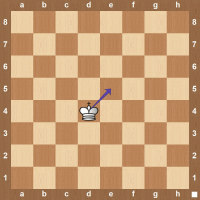

If one side attacks the opponents king that is called check. If the king is under attack and there are no moves that would keep the king from being capture that is checkmate, and the game is over. Take a look in ex. B where it’s white’s move. The king is under attack by black’s rook, but there are no safe squares for the white king to move to. This is checkmate and the game is over.
To take your game to the next level make sure you check out our complete guide on the king.
 The rook is the piece that looks like a castle. The is a very strong piece, also referred to as a major piece, and is outranked only by queen.
The rook is the piece that looks like a castle. The is a very strong piece, also referred to as a major piece, and is outranked only by queen.

Each side starts with two rooks located in the four corners of the board. Rooks are worth 5 points in chess. While points don’t tell the entire story in a chess game, it does give some indication for how strong a piece is. If you give up a 3 point piece in chess in exchange for your opponents rook, that is generally a good trade for you.
The rook can move any number of squares up, down, and across. It can’t jump over material so at the beginning of the game, it also can’t move.
At the beginning of the game the rook is surrounded by a pawn and a knight. One mistake that beginners make is they never unleash the rook into the game. The rook rarely gets involved early in the game but you need to find a way later in the game to use the rook or you will have missed out on of your strongest pieces contributing to the game.
When a rook moves you will see notation such as Re4. The R represents that a rook is moving and the e4 represents the square the rook is moving to. If the rook is capturing material on the e4 square the notation would be Rxe4. It’s also common to have two rooks that can move to the same square. In that case notation would be Re1e4. That means that the Rook from e1 is moving to e4. This is to limit any confusion about another rook that could also move to e4.

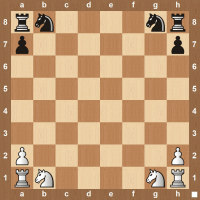

To take your game to the next level make sure you check out our complete guide on the rook.
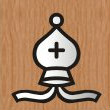 The bishop is not quite as strong as the rook, and is referred to as a minor piece. It can still cover a lot of ground and works will in pairs.
The bishop is not quite as strong as the rook, and is referred to as a minor piece. It can still cover a lot of ground and works will in pairs.

You begin with two bishops. They are located right next to the king and the queen. You will have one bishop that is on the light squares and one bishop on the dark squares. They will always stay on the same color square the entire game. The bishop is worth 3 points in a chess game, equivalent to a knight.
The bishop can move diagonally as many squares as it would like, without jumping over another piece. When a bishop moves you will see notation such as Be4. The B represents the bishop and e4 represents the square it is moving to. If the bishop is capturing material on e4 then it would be written as Bxe4. At the beginning of the game bishops are blocked by pawns, but you usually will be moving your pawns early on. The opens up the door for the bishops to get involved in the game. Bishops will be one of the primary pieces you will use in the early game to attack your opponent.
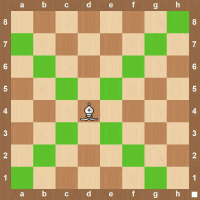

To take your game to the next level make sure you check out our complete guide on the bishop.
 The queen is the piece with a crown on top, but no cross. This is the most powerful chess piece and combines the moves of both the rook and the bishop. Like the rook, it is considered a major piece in chess.
The queen is the piece with a crown on top, but no cross. This is the most powerful chess piece and combines the moves of both the rook and the bishop. Like the rook, it is considered a major piece in chess.
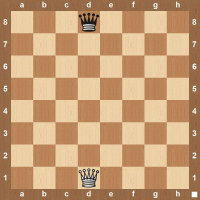
The queens begin on the d1 and d8 squares. This should be the same color as the queen. If you see the d1 square is a dark square then you need to rotate the board so the d1 square is a light color square. Using the queen correctly is one of the most important parts of chess. It is powerful, so you want to use it, but if it’s not protected your opponent can capture your queen and generally leads to a quick loss. The queen is worth 9 points, which is more than a rook a bishop combined.
The queen combines the moves from the bishop and rook. It can move any squares in a diagonal direction, or go up, down, and sideways as many squares without jumping over another piece.
When a queen moves you will generally see the notation as Qh4. The Q represents the queen and h4 represents the square the queen is moving to. If the queen is capturing material on h4 then it would be notated Qxh4.


Early in a chess game you usually don’t want to move your queen very much. It will support your pawns, bishops, and knights. As you approach the middle game (15 or so moves into the game), the queen will start to get involved a bit more and play more offense.
Because the queen is so powerful, there is a lot to consider in a game to use this piece correctly. To take your game to the next level make sure you check out our complete guide on the queen.
 The knight is the piece that looks like a horse. This is the most complicated piece to explain as it has a very unique movement. The knight is worth 3 points and is considered a minor piece. It is generally considered as strong as a bishop, but for its own unique reasons. While both pieces are worth 3 points, there will be some positions where the knight will reign supreme.
The knight is the piece that looks like a horse. This is the most complicated piece to explain as it has a very unique movement. The knight is worth 3 points and is considered a minor piece. It is generally considered as strong as a bishop, but for its own unique reasons. While both pieces are worth 3 points, there will be some positions where the knight will reign supreme.
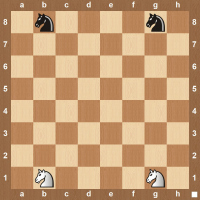
You begin with two knights. They will be located in between your rook and bishops on squares b1/g1 for white and b8/g8 for black.
The knight is the only piece on the board that can jump over another piece. In that way, the knight has a leg up on the queen, but controls fewer total squares than the queen can.
The movement of the knight can be thought of as an L. You can think of it as a two-one or a one-two approach. This means that the knight can move two squares up/down/sideways followed by one square to make an L or it can move one square up/down/sideways followed by two squares to make an L. Take a look at ex. C to see the possible squares a knight can go to.
As we mentioned before the knight can jump over material as well. This means that even if the knight is surrounded by material it can still move to the same number of squares (assuming the final destination isn’t occupied by another piece you own).



If a knight moves the notation would be Ne4. The N represents the knight (K is taken by the King) and e4 represents the square it moves to. If there are two knights that can both move to the same square then you would see Nd2e4. This means the knight from d2 moved to e4 instead of another knight that could also move to e4.
Because the knight can jump over material it is the only piece besides the pawns that can start the game off for one side.
To take your game to the next level make sure you check out our complete guide on the knight.
 The pawn is the basic piece in chess and each side starts with eight. Each pawn is worth 1 point. While that may not seem like a lot, many good chess players can win a chess game if they have a 1 point advantage.
The pawn is the basic piece in chess and each side starts with eight. Each pawn is worth 1 point. While that may not seem like a lot, many good chess players can win a chess game if they have a 1 point advantage.

While the pawn is the weakest piece on the board, it serves a vital role in the game. Most of the early part of the game will be centered around the pawn structure and controlling the center of the board with your pawns. The other pieces will support the pawn in the early stages. Later on the pawns will play more of a supportive role for the minor and major pieces will limiting the squares the opponent can go to.
The pawn is the only piece on the chess board that can’t go backwards. It is also the only piece where you can’t move it the same number of squares the entire game. The first time you move a pawn you can move it one or two squares. Once the pawn has moved you can only move the pawn one square after that.
Another distinction is that while the pawn moves forward it can’t capture another piece right in front of it. It can only capture a piece diagonally, but it can’t move diagonally unless it is capturing a piece. Look at ex. D and you can see that the pawn on d5 can’t take the pawn on d6 (located directly in front of it). Instead the only move the pawn can make is to take the pawn on e6.
When a pawn moves you will see the notation e5. This is different from other pieces in that you don’t see a letter specifying what piece is moving. If you only see a square that means the pawn is moving there. If a pawn from d5 is capturing a pawn on e6 then you would see the notation exd6.

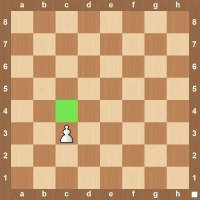
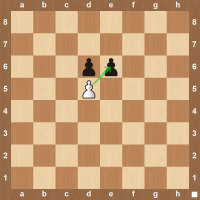
There is only special move that a pawn can make called en passant. This can occur only immediately after a pawn moves two squares. If you have a pawn next to the pawn after it has moved two squares you can take this pawn with en passant but you only have one move. Any other move you make will negate the possibility to use en passant.
Ex. E & F show an example of en passant. White has just moved d4. Black has a pawn on c4 and has one move only to play cxd3. It is a strange move as the black pawn does not actually end up on a square that is occupied by a white piece but it does in fact capture the white pawn on d4. This usually ends with a confused opponent if they have never seen it, but you can always send them to this site in case you need to prove that it’s a legal move.

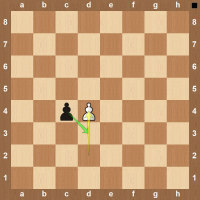
To take your game to the next level make sure you check out our complete guide on the pawn.
Now you have a basic understanding of how pieces move, how many points each piece is worth, and how to read notation from a chess game. Be sure to check out other topics in our chess basics series to learn more.